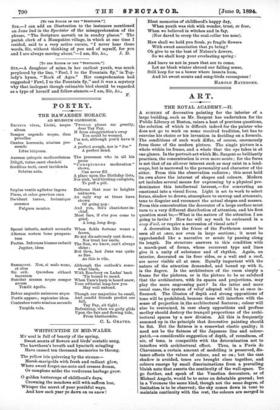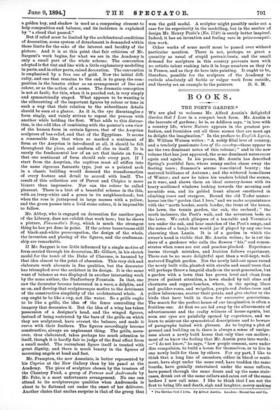ART.
THE ROYAL ACADEMY.—II.
A SCHEME of decorative painting for the interior of a large building, such as Mr. Sargent has undertaken for the Public Library at Boston, raises a host of previous questions, the solution of which is difficult indeed for the painter who does not go to work on some received tradition, but has to exercise his choice or his invention in deciding on a formula. The conditions of such work differ, of course, enormously from those of the modern picture. The single picture is a whole within its frame, and a whole that the eye takes in at one glance. In the portrait-art which Mr. Sargent so brilliantly practises, the concentration is even more acute ; for the focus is not that of an all-over interest such as may exist in a land- scape, but is narrowed to the personality and character of the sitter. From this the observation radiates ; this must hold its own above the interest of shapes and colours. Modern art includes several means for expressing by a physical pre- dominance this intellectual interest, — for converting an emotional into a visual focus. Light is set to work to select forms, shadow to drown, atmosphere to enwrap and attenuate, tone to disguise and reconnect the actual shapes and masses. From this concentration the decorator of a large surface must turn to a very different distribution of attention, and his first question must be,—What is the nature of the attention I am going to invite ? How far will my work be embraced in a coup d'ceil, or require a succession of visual acts ?
A decoration like the frieze of the Parthenon cannot be seen all at once, nor even in large sections; it must be apprehended like a narrative or music by passing along its length. Its structure answers to this condition with a march-past of forms, whose recurrent type and lines give it a unity of substance and of rhythm. Again, an interior, decorated on its four sides, or a wall and a roof, are never visible all at once. Equally important with the nature of the attention demanded, and bound up with it, is the degree. Is the architecture of the room simply a frame for the pictures, or is the picture to be so subdued that the architecture, with its spaces and projections, may play the more engrossing part ? In the latter and more usual case, the system of relief adopted will be at once in- fluenced. The illusion of depth and strong oppositions of tone will be prohibited, because these will interfere with the sense of projection in.the architectural features ; colour will also be restrained, in case sharp oppositions and profuse medley should destroy the tranquil proportions of the archi- tectural spaces by a new division. All this is frequently summed up in the principle that decorative painting should be flat. But the flatness is a somewhat elastic quality; it need not be the flatness of the Japanese line and colour- patch,—a considerable suggestion of depth, of roundness, of air, of tone, is compatible with the determination not to
interfere with architectural effect. Thus, in a Pavia de Chavannes, a certain amount of modelling is preserved, dis- tance affects the values of colour, and so on ; but the cast shadow is avoided, tones are brought close together, and colours emerge by small discriminations from a prevailing bluish note that asserts the continuity of the wall-space. To go further, and speak of the Venetian decorators, or of Michael Angelo, would be to enter on debatable ground; but in a Veronese the same kind, though not the same degree, of limitation is to be observed ; the sky comes down in tone to maintain continuity with the rest, the colours are merged in a golden key, and shadow is used as a composing element to help composition and balance, and its incidence is explained by "a cloud that passed."
But if relief must be limited by the architectural conditions of decoration, some system of detachment is demanded within these limits for the sake of the interest and lucidity of the picture. And it is at this point that fair criticism of Mr. Sargent's work begins, for what we see in the Academy is only a small part . of the whole scheme. The convention adopted is flat tint and line with a little explanatory modelling in parts, and in other parts, raised decoration. The convention is emphasised by a free use of gold. Now the initial diffi- culty, and one that remains to the end, is to grasp the com- position in the lunette either as an arrangement of line and colour, or as the action of a scene. The dramatic conception is not at fault; for this, when it is puzzled out, is very simply and symmetrically staged. What appears to be wanting is the silhouetting of the important figures by colour or tone in such a way that their relation to the subordinate details should be seen at a glance. As it is, the eye disentangles a form singly, and vainly strives to repeat the process with another while holding the first. What adds to this distrac- tion, is the odd idea of combining with the painter's own view of the human form in certain figures, that of the Assyrian sculptors of bas-relief, and that of the Egyptians. It seems a reasonable idea that when so marked a sentiment of form as the Assyrian is introduced at all, it should be felt throughout the piece, and conform all else to itself. It is surely the fundamental law of an art that insists on form, that one sentiment of form should rule every part. If I start from the Assyrian, the captives must all stiffen into the same rigorous fantastic type, just as a pointed arch in a classic building would demand the transformation of every feature and detail to accord with itself. The result of this collection out of Perrot and Chipiez is more bizarre than impressive. Nor can the colour be called pleasant. There is a hint of a beautiful scheme in the ibis, with an ivory-white and a green in its neighbourhood ; but when the rose is juxtaposed in large masses with a yellow, and the green passes into a livid stone colour, it is impossible to follow.
Mr. Abbey, who is engaged on decoration for another part of the Library, does not exhibit that work here ; but he shows a picture, Fiammetta's Bong, which is much the strongest thing he has yet done in paint. If the colour bears traces still of black-and-white preoccupation, the design of the whole, the invention and placing of the figures, and the craftsman- ship are remarkable.
If Mr. Sargent is too little influenced by a single motive of form carried through his decoration, Mr. Gilbert, in his sketch model for the tomb of the Duke of Clarence, is haunted by that idea almost to the point of obsession. This very rich and elaborate work abounds in fine qualities, but the decorator has triumphed over the architect in its design. It is the same want of balance as was displayed in another interesting work by the same author, the Shaftesbury Fountain. In that, one saw the decorator become interested in a wave, a dolphin, and so on, and develop that sculpturesque motive to the detriment of the constructive simplicity of the architectural whole. A cup ought to be like a cup, not like water. So a grille ought to be like a grille, the idea of the fence controlling the imagery that decorates it. But the idea of a wing has taken possession of a designer's head, and the winged figures, instead of being restricted by the bars of the grille on which they are sculptured, have overset the balance, and made it curve with their feathers. The figures accordingly become constructive, always an unpleasant thing. The grille, more- over, thus elaborated, takes perhaps too much attention to itself, though it is hardly fair to judge of the final effect from a small model. The recumbent figure itself is treated with great dignity, and there is much beauty in the figures of mourning angels at head and feet.
Mr. Frampton, the new Associate, is better represented by his Caprice at the New Gallery than by his panel at the Academy. The piece of sculpture chosen by the trustees of the Chantrey Fund, a group of Perseus and Andromeda by Mr. Fehr, is a most unfortunate arrangement. No one can attend to its sculpturesque qualities when Andromeda is about to be flattened out under the onset of her deliverer. Another choice that excites surprise is that of the group that won the gold medal. A sculptor might possibly make out a case for its superiority in the modelling, but in the matter of design Mr. Henry Poole's (No. 1749) is surely better inspired. Indeed, it has an invention and feeling rare in prize-competi- tion work.
Other works of some merit must be passed over without particular mention. There is not, perhaps, so great a quantity as usual of stupid portrait-busts, and the small demand for sculpture in this country prevents men with no artistic talent rushing into it in huge numbers as they do in Prance, and as they do here into painting. It ought to be, therefore, possible for the sculptors of the Academy to exclude absolutely all feeble or vulgar work from outside, and thereby set an example to the painters. D. S. IL







































 Previous page
Previous page